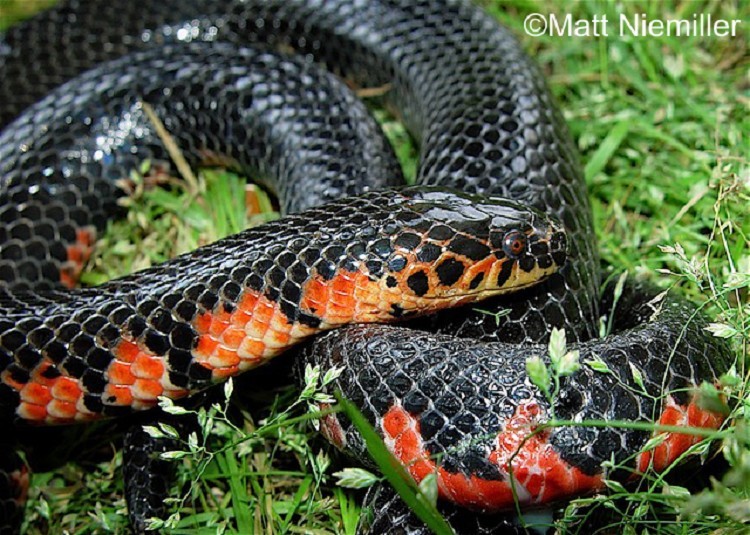Red-bellied Mudsnake
One subspecies, Western Mudsnake (F. a. reinwardtii), occurs in the western coastal plain of Tennessee.
Description: A large, heavy-bodied snake (40.0 to 54.0 inches in length), which is semi-aquatic. Smooth, glossy black snake with a red and black checkered belly; red extends up onto sides creating red triangle pattern.
Chin heavily marked with black and may be yellowish creating a “zipper-like” appearance. Males are smaller and have shorter tails than females. Young have sharp tail tips in contrast to blunt tips for adults.
Similar Species: Copper-bellied Watersnake has solid reddish belly.
Habitat: Typically found in stagnant, muddy waters of shallow streams, rivers, and swamps. Often found under rotten or water-soaked logs, or other debris.
Diet: Specialized diet preference of Three-toed Amphiuma or Lesser Siren.
Breeding information: Adults breed in spring. Females lay 11-50 leathery, creamy white eggs in sandy nest burrows or rotten logs. Females remain with their clutch of eggs until they hatch in late summer or early fall. Hatchling mudsnakes remain in the nest over the winter until the following spring.
Status in Tennessee: Infrequently seen due to its secretive nature; hence status poorly known.
Fun Facts:
- Mudsnakes are known as “horn snakes” or “stinging snakes” because of its behavior of pressing its hard-tipped tail against the skin of its captors.
- Mudsnakes may play dead or go limp if handled too much.
Best places to see in Tennessee: Shallow waters and streams around Reelfoot Lake.
Sources:
Conant, R. and Collins, J. 1998. Peterson Field Guides: Reptiles and Amphibians (Eastern/Central North America). Houghton Mifflin Company, New York. 616pp.
Jensen, J. B., Camp C. D., Gibbons, W., and Elliot, M. J. 2008. Amphibians and Reptiles of Georgia, University of Georgia Press, Athens, GA. 575pp.
Johnson, T.R. 2006. The Amphibians and Reptiles of Missouri. The Missouri Department of Conservation, Jefferson City, MO.
